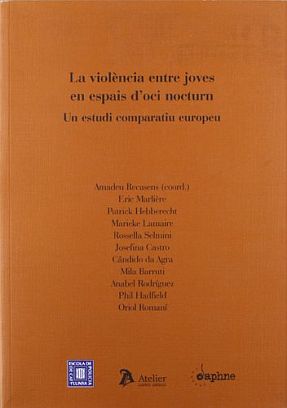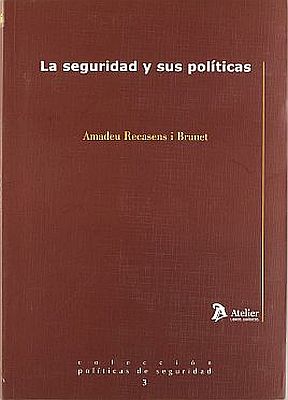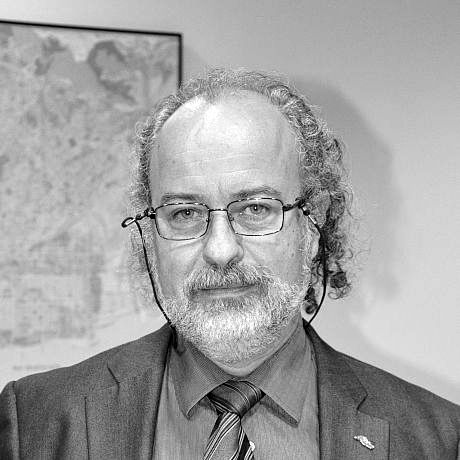Understanding problems, thinking about policies, promoting security
- Urban visions
- Apr 19
- 9 mins

The significant rise in minor offences in Barcelona highlights a series of circumstances that have affected security: globalisation, the 2017 terrorist attack, the pro-independence demonstrations... coupled with the poor functioning of the judicial system and the lack of enough officers for the police force. With a good assessment, we will be able to cope with this situation.
“Barcelona is a safe city.” This statement could raise doubts, or even contradictory interpretations. That is why we must really explain what we mean when we make such an assertion. The first thing to note is that there are no “safe cities” and that a certain rate of punishable acts is inherent in every population. In large cities, the crime rate is higher because there is more anonymity, more opportunities to commit crime and less chance of being detected.
There are two basic factors. The first is that a large city like Barcelona is part of a phenomenon called “globalisation”. As Zygmunt Bauman points out, this circumstance has consequences: “cities have become dumping grounds for globally begotten problems. The residents of cities and their elected representatives have been confronted with a task they can by no stretch of imagination fulfil: the task of finding local solutions to global contradictions. [...] Contemporary cities are the battlefields where world powers coincide with each of their inhabitants’ stubborn reason for being”.[1] We must add that crime is part of this globalisation, and municipalities generally do not have the financial, legal or institutional resources to deal with it. Our city is no exception.
The second factor refers to the context: Barcelona is the capital of a major autonomous community. The fact that reported crimes have risen 17.7% in one year requires an interpretation contextualising the phenomenon.[2] This interpretation is complex but essential, because an accurate diagnosis would enable us to recognise the real problems, identify the public policies and develop the actions necessary to solve them. Furthermore, not acknowledging or distorting the problems consciously leads us to demagoguery and confusion, making the people practicing them part of the problem and not the solution.
The number of reported criminal offences in Barcelona remained relatively stable from 2013 to 2016, and it is from 2017 that it began to curve disturbingly upward. The nature of the offences that caused this increase, and the places where they take place most frequently, are clear. We are not talking about a significant increase in major crimes against people’s lives or integrity, but about theft and robbery on the street, in shops and on public transport. They take place in districts with large flows of people, high levels of tourism and spacious leisure areas, such as Ciutat Vella, Eixample, Sants-Montjuïc and Sant Martí.
1 Zygmunt Bauman (2009), Confianza y temor en la ciudad [originally published in English as City of Fears, City of Hopes], Barcelona, Arcadia (p. 23 and p. 25).
[2] All the figures set forth in this article were taken from data of the Local Security Board of 22 October 2018.
The events of 1 October 2017 and the application of Article 155 of the Constitution created a situation with major consequences for security and the police.
What started happening in 2017?
On 17 August 2017, there was a serious terrorist attack on the Rambla in Barcelona. Although the post-attack response by the police, medics, firefighters and general public could be described as very good, it is no less true that the subsequent reinforcement of particularly sensitive points obliges the police, especially the Mossos d’Esquadra police force, with the support of the Guàrdia Urbana police force, to undertake a series of protection and self-protection operations and to strengthen strategic surveillance sites. This still accounts for a significant increase in police work in Barcelona and throughout Catalonia, even today.
Furthermore, the events of 1 October 2017 and the central government’s application of Article 155 of the Constitution created a situation with major consequences for security and the police. In one year, the Catalan Ministry of the Interior witnessed the change of three ministers, a temporary manager for implementing Article 155, three general managers and three heads of the body, as well as procedures against much of the top brass of the Mossos d’Esquadra. The purge of the senior officials of the Catalan Ministry of the Interior and the Mossos d’Esquadra left the regional police force leaderless for many months, during which time the Guàrdia Urbana city police force of Barcelona had to redouble its efforts to provide an adequate presence on the street.
The extraordinary rise in demonstrations and gatherings resulting from these events have forced changes in all police services to date. Both the Mossos, dealing with public order, and the Guàrdia Urbana, faced with blocked roads and detours, have allocated many officers to the protection of each event. Moreover, if the demonstrations or gatherings are not announced, some services planned to deal with such contingencies must be taken apart.
To this situation, we must add two aggravating factors. The first is the impossibility of hiring more police officers, as staff levels are affected by state contingent budget laws, which provide just enough to fill the vacancies that occur due to sickness, injury and retirement (the substitution of officers had to be alleviated through extra hours, to the extent possible, costing millions of euros). The second factor is the uncertainty caused by the government with its decree of local police retirement starting at age 60. Despite being positive, the measure was managed behind the backs of the city councils, with invalid information and without planning for the retired officers to be gradually replaced. It was not properly calculated that the period necessary for selecting and training new officers is almost a year and a half, creating significant gaps between policemen’s exit and entry.
 EVOLUTION OF CRIMINAL OFFENCES IN BARCELONA
EVOLUTION OF CRIMINAL OFFENCES IN BARCELONAFont: Local Security Board
© Astrid Ortiz
We still need to add an issue that we could call decisive: this is the operation of the judicial and criminal system in a way that leads to distortions and impunity. The nine-month delay in trials for misdemeanours is unacceptable. These are cases that should be judged within a maximum period of eight days and are limited to one year; meaning that they are near the end of the statute of limitations. This is because only one court handles these cases, so it is incapable of absorbing the workload connected with the rise in crimes of this type, thereby increasing police activity to prevent them. Due to the persistent demand of Barcelona City Council, conveyed by the Court Clerk’s Office and the Catalan Ministry of Justice of the Government of Catalonia, a provisional second court opened in February 2019. We will have to see how it develops and how effective it is.
Moreover, we have a criminal justice system that does not seem to foresee that these misdemeanours can be committed by organised and professional groups. The feeling of impunity was even greater when Sentence 481/2017 of 28 June excluded the possibility of charging those who commit such crimes with multiple recidivism. It should also explore continued crime as an aggravating factor for sentencing. This is being done, but with a difficult and complicated jurisprudential structure. However, tougher punishment is a solution whose effectiveness is doubtful, unless accompanied by expeditious and persistent judicial and procedural measures. Otherwise, we only resort to the “easy” solution of increasing punitive populism without really exploring all the options provided under current law and without solving the problems in people’s daily lives.
Therefore, the judicial system raises many unknowns: how will the second court operate in terms of efficiency? What real impact is Sentence 481 having on Barcelona, Catalonia and the Spanish central government? How can we optimise the legal and procedural resources of current legislation to deal with this type of crime?
We must demand solutions to the impunity stemming from a criminal justice system’s inadequate response, which discourages the people and the police forces.
No magic solutions
If we have raised a plausible explanatory framework here, the problem of insecurity could lead to two conclusions. The first is that it would not be peculiar just to Barcelona, but to all of Catalonia. The second is that it is not comparable to other cities or parts of the country, since they did not suffer from the application of Article 155 and have not experienced comparable socio-economic development (tourism, gentrification, urban speculation, etc.). Regarding the extension of the phenomenon, theft and crimes against cultural property have grown, to a greater or lesser extent, across Catalonia.
There are no magical solutions or miracle cures to deal with this situation, and there is no silver bullet, but we must still do something serious and enduring. First, and this is essential to understand, we must accurately identify and measure the problem, its causes and its scope, in order to tackle it from a complex and multifactorial perspective.
Second, we must design specific public security policies that are clear and understandable and foster people’s participation and engagement. This will not be effective without the institutions and the people’s joint effort and involvement in understanding the problem and in searching for specific solutions adapted to the area. Every public policy must be led by the public authorities and have real concreteness, close to the people. The implementation of policies of engagement and transparency and responses such as the district police in Barcelona are all efforts to further this line of action.
Third, nothing will be possible without close and loyal cooperation between public institutions that does not rule out the involvement of private security agencies. This effort must be led via public services and view all residents (not just the voters for each choice) as recipients/beneficiaries of security policies. In this regard, the efforts exerted by Barcelona City Council towards effective institutional cooperation between City Hall and the Government of Catalonia have led to the launch of a shock plan for Ciutat Vella and joint operations with other sectors, such as Renfe and TMB, which are giving positive results but require reliability and continuity.
Fourth, we must demand solutions to the impunity stemming from the criminal justice system’s inadequate response, which discourages the people and the police forces.
In organisational terms, we must improve how the police forces operate, helping them to adapt to the social changes in their environment, take advantage of human and material resources more efficiently and increase recruitment reasonably and justifiably. The implementation of the Master Plan of the Guàrdia Urbana of Barcelona, with its restructuring and suggestions for improvement, is a step in this direction. And training is fundamental.
These measures offer possible and necessary solutions and their impetus is beginning to reverse the effects of the undesirable situation in 2017. Now we have to watch to make sure it stays reversed, and above all, to not let it happen again.
Publicacions recomanades
 La violència entre joves en espais d'oci nocturn: un estudi comparatiu europeuAtelier, 2007
La violència entre joves en espais d'oci nocturn: un estudi comparatiu europeuAtelier, 2007 La seguridad y sus políticasAtelier, 2007
La seguridad y sus políticasAtelier, 2007
The newsletter
Subscribe to our newsletter to keep up to date with Barcelona Metròpolis' new developments




